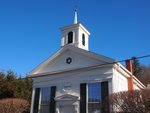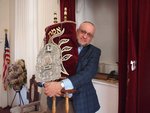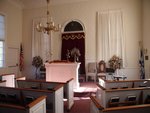 Narrowsburg
NarrowsburgLight Rain Fog/Mist, 43°
Wind: 8.1 mph
 Narrowsburg
NarrowsburgHONESDALE, PA — Congregation Beth Israel in Honesdale “was organized in 1849, by—it depends whom you ask—by 10 or 11 men of the community,” says Rabbi Elliott Kleinman. …
Stay informed about your community and support local independent journalism.
Subscribe to The River Reporter today. click here
This item is available in full to subscribers.
Please log in to continue |



HONESDALE, PA — Congregation Beth Israel in Honesdale “was organized in 1849, by—it depends whom you ask—by 10 or 11 men of the community,” says Rabbi Elliott Kleinman. “They came together to create a community for Jews who worked for the canal company. The whole town was a canal company town. The land was given [to] them by the canal company on the premise that they had to build. And so by 1856, they had a building erected. The reason we have a steeple is… that R.L. Lord, the benefactor—he was the director of the Delaware Hudson Canal Company—he donated the piece of land, he also said that we had to have a steeple on top, and so we have a steeple.
“Not much has changed in this congregation. This is the original building from 1856, for better or worse—the same tin walls, the same Tiffany lamps.” He points to small knobs on a ceiling lamp that “don’t twist anymore,” but were once used to control the gas. “We are the second-oldest continually-operating Reform congregation in the United States. We were originally founded as a German congregation, which meant men and women could sit together… They were German workers who worked for the canal company. German was the language of the congregation until 1875—the record books were kept in German. We have them in a safety deposit box over in Hawley. We’ve had them translated.
“We’re about one-third families who are connected for more than a generation; about one-third families who are new to the area, joined up because they have a home up here; and about one-third folks who aren’t even nearby, but believe in the extraordinary history of this congregation and want to help to maintain it. The community now has evolved from a community that was overwhelmingly local, to not at all local. Come services in the summer, you’ll find 30, 40 people at a typical Friday night service. Come services in the winter, you’ll find 15 or 18 or 20. And that’s because a lot of our folks are snowbirds now. They’re headed down to Florida or Arizona for the winter. On the other hand, we livestream our services, and we get people from literally all over the world who watch our services in our little congregation, because they want to be part of the kind of goodness and kindness and intimacy that this congregation offers. When you sit in a room of this size with the congregation, you can’t help but know everybody. You can’t get lost, you can’t be anonymous. That’s part of what’s so nice about it. When somebody has something to celebrate, everybody celebrates. When somebody is mourning, everybody is mourning. And that’s what makes a congregation of this size so special and very unique.”
The congregation has long considered how best to modernize its services. “In any religion, and certainly in Jewish tradition, that is always the case. Whether you’re in a congregation of 85 or 90 families in Pennsylvania, or whether you’re in a congregation of 2,000 families in Manhattan, that tension exists regardless. And part of the way that tension is addressed is with an extraordinary respect for the history. And that respect says that we maintain certain things, we change certain things, we experiment with ideas—and change is never easy, because everybody believes that the way they grew up with something is the way it’s supposed to be.”
“But also I think that things you grow up with hearken back, offer comfort, and there’s something deeply moving about knowing that your grandmother sang it, and your great-grandmother,” says Liza Roos Lucy, president of the synagogue leadership. “I sit here, and I still hear my Aunt Amy sing two beats behind everybody else. She hasn’t been here for a very long time, but she’s still here….
“When I was a child, there was no rabbi. It was a period of time in, say the ‘40s, ‘50s, ‘60s, that the men in town took turns leading services every Friday night—not in the summer, only in the winter—and then would go back to work, because Friday night was business night in Honesdale. Just a reality. And then we would have a student rabbi for the High Holy Days. Practicing Judaism in Honesdale took an effort. It was not simple. So a real effort was made by the families here, and our faith was kept alive in an otherwise gentile community. We were well integrated, but we were apart.”
Modern concerns, however, are not restricted to the complexities of faith. “One of the unfortunate realities of modernity is that we now have a security camera,” says Rabbi Kleinman. “That’s part of the world in which we live on a variety of levels. We have been very fortunate that there has been no vandalism or anti-Semitic violence in this community. For a long time, that hasn’t happened. But we see a resurgence of it in the news, and we would be fools not to be worried. We are endlessly grateful to the community that continues to support us and welcome us. But we have to face realities. [The solution is] to be present. That’s the secret—the secret is to keep our doors open, to continue to invite groups to come visit, whether they’re studying history, there are kids’ classes that come in, church groups... We try to be as present to the community as we possibly can, and that helps. The way you combat it is not by condemning—as much as it needs to be condemned—or by hiding. It’s by engaging, and that’s what we do.”
Congregation Beth Israel is located at 615 Court St. in Honesdale. For more, visit www.congregationbethisraelhonesdale.org.
Comments
No comments on this item Please log in to comment by clicking here